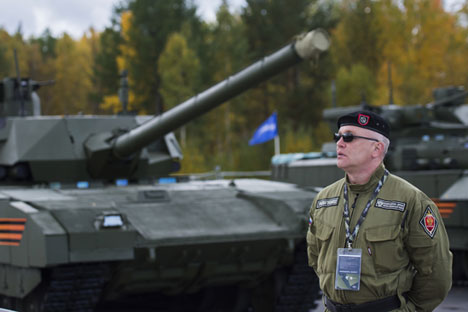Life after the parade for Armata

Armata tank guard at the 10th Russia Arms Expo.
RIA Novosti_Alexey MalgavkoBarely a handful of countries manufacture armoured vehicles, and they rarely show major innovations in this sector. Such a large-scale upgrade of the national armoured fleet happened in Russia because of a change in the ideology of military construction, and a transition from a mass mobilization type army, to a more compact and efficient armed force.
The Armata is a platform on which a wide range of heavy military vehicles will be built, able to operate in difficult counter-fire conditions; the T-14 Armata main battle tank, T-15 armoured personnel carrier, Koalitsiya-SV self-propelled artillery platform, and the T-16 armoured recovery vehicle (ARV).
Less than a year after the 2015 Victory Day Parade, it has become clear that massive implementation of this technology cannot be expected in the near future. Until 2020, only individual units will be equipped with the T-14 Armata. For now, a pilot test-batch of 20 tanks is being produced. Troops operating these would be able to identify shortcomings, which can be eliminated before bulk purchases begin.
The delivery of T-15 armored personnel carriers and Koalitsiya-SV self-propelled artillery platforms will probably start either simultaneously, or after the T-14 tanks. Meanwhile, Russian industry is developing components for production of the Armata.
In 2015, mass production of ceramic armour, communication engines and electronic systems for the heavy platform started. Work is also on to manufacture vehicles, based on the Armata platform, for export. This would reduce the cost per unit for the Russian armed forces.
The middle combat platform – Kurganets-25
The Kurganets-25 is the second of the trio of the new armoured vehicles. It is almost 10 tons heavier than the most modern armoured vehicle now in service with the Russian Army – the BMP-3. Additionally, the Kurganets can swim, unlike the T-15. Future crews will find themselves equipped with powerful weapons and advanced active and passive defence systems. This machine should protect lives of the crew and assault troops significantly better than the BMP, labelled by the military as the “fraternal infantry grave” (from the first letters of the Russian abbreviation – BMP = bratskayamogilapekhoty). It is possible to install various weapons modules and build infantry combat vehicles (cannon armaments) and APCs (machine-gun armaments) on this platform. Testing of these machines should be completed by 2016, and mass production is planned in 2017-2018.
Albert Bakov, first vice-president of TraktornyyeZavody Concern, which manufactures the Kurganets platform, said in August 2015 that completion of research and development (R&D) schedules on the Kurganets-25 middle combat platform had been shifted by a year, so state testing will begin only in 2017.
The combat platform – Boomerang
The Boomerang will eventually replace the BTR-80 and BTR-82 family of wheeled armoured personnel carriers and older APCs in the Russian Army. This new fighting machine can withstand fire from high-calibre machine guns and grenades,it can swim and, at the same time, carry various weapons modules. Infantry combat vehicles and wheeled APCs can be built on this base.
At the beginning of 2016 Alexander Krasovitsky, general director of the Military-Industrial Company (Voyenno-PromyshlennayaKompaniya), which has developed the new APCs, announced that testing of the Boomerang had started. Mass production of the Boomerang is planned in 2017, and large-scale deliveries to the armed forces in 2019.
As with the Armata and the Kurganets, manufacturing enterprises are actively looking for foreign buyers and partners to refine their products, said Krasovitsky, adding that the company is ready to supply the Boomerang for export, as soon as it receives permission from the government.
All rights reserved by Rossiyskaya Gazeta.
Subscribe
to our newsletter!
Get the week's best stories straight to your inbox
